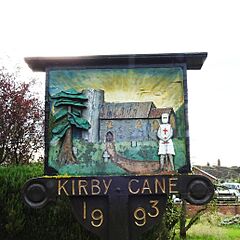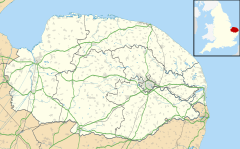Kirby Cane facts for kids
Quick facts for kids Kirby Cane |
|
|---|---|
 Kirby Cane Village Sign |
|
| Area | 3.78 sq mi (9.8 km2) |
| Population | 449 |
| • Density | 119/sq mi (46/km2) |
| OS grid reference | TM373941 |
| Civil parish |
|
| District |
|
| Shire county | |
| Region | |
| Country | England |
| Sovereign state | United Kingdom |
| Post town | BUNGAY |
| Postcode district | NR35 |
| Dialling code | 01508 |
| Police | Norfolk |
| Fire | Norfolk |
| Ambulance | East of England |
| EU Parliament | East of England |
| UK Parliament |
|
Kirby Cane is a small village and civil parish in the English county of Norfolk. It's a lovely place located near the River Waveney.
You can find Kirby Cane about 3.8 miles (6.1 km) north-west of Beccles. It is also about 3.4 miles (5.5 km) south-east of Norwich.
Contents
Village History
The name Kirby Cane comes from the Vikings. It means "the church farmstead of the Cane family" in Old Norse.
In the Domesday Book, which was a big survey from 1086, Kirby Cane was listed. It had 28 households back then. The village was split between three important landowners. These were Hugh d'Avranches, Earl of Chester, Bury St Edmunds Abbey, and Ralph Baynard.
In the 1600s, a large red-brick house called Kirby Cane Hall was built. It was later updated in the 1700s and 1800s.
During the Second World War, some trenches were dug near Kirby Cane Hall. This suggests the area might have been used for training soldiers.
Village Population
According to the 2021 census, Kirby Cane has 449 people living there. This number has grown a little since the 2011 census, which recorded 434 people.
All Saints' Church
Kirby Cane's main church is called All Saints' Church. It is a very old building from the Middle Ages. This church is special because it has a round tower. Norfolk has 124 of these unique churches.
All Saints' Church is on Wash Lane. It has been a Grade I listed building since 1960. This means it is a very important historical building. The church holds a Sunday service once a month. It is part of a group of churches called the Waveney Marshlands Benefice.
Inside the church, you can see a font from the 1300s. There is also a special brass plaque that remembers someone important.
How the Village is Governed
Kirby Cane is part of the Ditchingham & Earsham area for local elections. This area is part of the South Norfolk district.
For national elections, the village is in the Waveney Valley area. This area has been represented by Adrian Ramsay MP from the Green Party since 2024.
War Memorial
Kirby Cane has a war memorial inside All Saints' Church. It is made of marble plaques. These plaques list the names of people from the village who died in the First World War and the Second World War.
First World War Names
- LSjt. Hubert Strowger
- LSjt. Leonard A. Watson
- Pte. William C. Buck
- Pte. Percy F. Buck
- Pte. Charles Buck
- Pte. Albert Grimwood
- Dhd. Arthur Baldry
Second World War Names
- LSt. John C. Sutton
- LTel. Ieuan L. G. Winchester
- Pte. Frederick Spurgeon
- Pte. Jeremiah W. Brister
- Pte. Alfred F. Ward
See Also
- Clavering hundred


